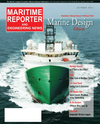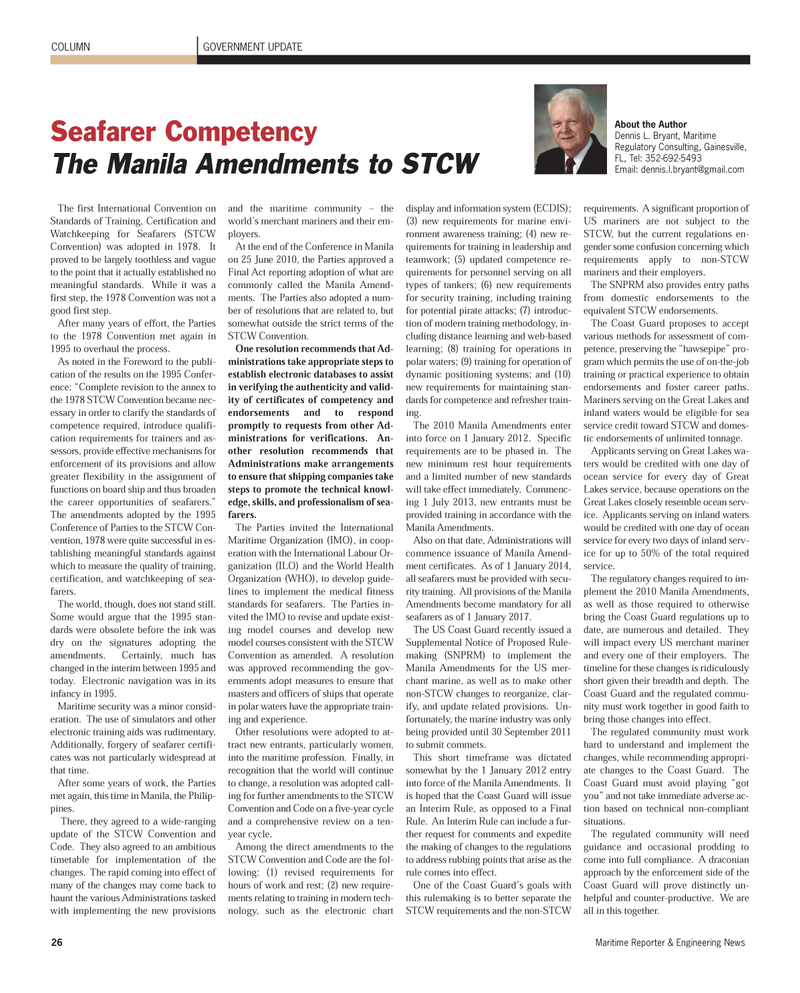
Page 26: of Maritime Reporter Magazine (October 2011)
Marine Design Annual
Read this page in Pdf, Flash or Html5 edition of October 2011 Maritime Reporter Magazine
26Maritime Reporter & Engineering News The first International Convention on Standards of Training, Certification and Watchkeeping for Seafarers (STCW Convention) was adopted in 1978. It proved to be largely toothless and vague to the point that it actually established nomeaningful standards. While it was a first step, the 1978 Convention was not a good first step. After many years of effort, the Parties to the 1978 Convention met again in 1995 to overhaul the process. As noted in the Foreword to the publi- cation of the results on the 1995 Confer- ence: ?Complete revision to the annex to the 1978 STCW Convention became nec- essary in order to clarify the standards ofcompetence required, introduce qualifi- cation requirements for trainers and as-sessors, provide effective mechanisms for enforcement of its provisions and allow greater flexibility in the assignment of functions on board ship and thus broadenthe career opportunities of seafarers.? The amendments adopted by the 1995Conference of Parties to the STCW Con- vention, 1978 were quite successful in es- tablishing meaningful standards against which to measure the quality of training,certification, and watchkeeping of sea- farers. The world, though, does not stand still. Some would argue that the 1995 stan- dards were obsolete before the ink was dry on the signatures adopting theamendments. Certainly, much has changed in the interim between 1995 andtoday. Electronic navigation was in its infancy in 1995. Maritime security was a minor consid- eration. The use of simulators and other electronic training aids was rudimentary. Additionally, forgery of seafarer certifi- cates was not particularly widespread at that time.After some years of work, the Parties met again, this time in Manila, the Philip- pines. There, they agreed to a wide-ranging update of the STCW Convention and Code. They also agreed to an ambitious timetable for implementation of thechanges. The rapid coming into effect of many of the changes may come back to haunt the various Administrations tasked with implementing the new provisions and the maritime community ? theworld?s merchant mariners and their em- ployers. At the end of the Conference in Manilaon 25 June 2010, the Parties approved a Final Act reporting adoption of what are commonly called the Manila Amend- ments. The Parties also adopted a num- ber of resolutions that are related to, but somewhat outside the strict terms of the STCW Convention. One resolution recommends that Ad- ministrations take appropriate steps to establish electronic databases to assist in verifying the authenticity and valid- ity of certificates of competency and endorsements and to respond promptly to requests from other Ad- ministrations for verifications. An- other resolution recommends that Administrations make arrangements to ensure that shipping companies take steps to promote the technical knowl- edge, skills, and professionalism of sea- farers. The Parties invited the International Maritime Organization (IMO), in coop- eration with the International Labour Or- ganization (ILO) and the World Health Organization (WHO), to develop guide- lines to implement the medical fitness standards for seafarers. The Parties in- vited the IMO to revise and update exist- ing model courses and develop new model courses consistent with the STCWConvention as amended. A resolution was approved recommending the gov- ernments adopt measures to ensure thatmasters and officers of ships that operate in polar waters have the appropriate train- ing and experience. Other resolutions were adopted to at-tract new entrants, particularly women, into the maritime profession. Finally, in recognition that the world will continue to change, a resolution was adopted call- ing for further amendments to the STCWConvention and Code on a five-year cycle and a comprehensive review on a ten- year cycle. Among the direct amendments to theSTCW Convention and Code are the fol- lowing: (1) revised requirements for hours of work and rest; (2) new require- ments relating to training in modern tech-nology, such as the electronic chart display and information system (ECDIS);(3) new requirements for marine envi- ronment awareness training; (4) new re- quirements for training in leadership andteamwork; (5) updated competence re- quirements for personnel serving on alltypes of tankers; (6) new requirements for security training, including trainingfor potential pirate attacks; (7) introduc-tion of modern training methodology, in- cluding distance learning and web-basedlearning; (8) training for operations inpolar waters; (9) training for operation of dynamic positioning systems; and (10)new requirements for maintaining stan- dards for competence and refresher train-ing.The 2010 Manila Amendments enter into force on 1 January 2012. Specific requirements are to be phased in. The new minimum rest hour requirements and a limited number of new standards will take effect immediately. Commenc- ing 1 July 2013, new entrants must be provided training in accordance with the Manila Amendments. Also on that date, Administrations will commence issuance of Manila Amend- ment certificates. As of 1 January 2014, all seafarers must be provided with secu- rity training. All provisions of the Manila Amendments become mandatory for allseafarers as of 1 January 2017. The US Coast Guard recently issued aSupplemental Notice of Proposed Rule-making (SNPRM) to implement theManila Amendments for the US mer- chant marine, as well as to make other non-STCW changes to reorganize, clar- ify, and update related provisions. Un- fortunately, the marine industry was only being provided until 30 September 2011 to submit commets. This short timeframe was dictated somewhat by the 1 January 2012 entry into force of the Manila Amendments. It is hoped that the Coast Guard will issuean Interim Rule, as opposed to a FinalRule. An Interim Rule can include a fur- ther request for comments and expedite the making of changes to the regulations to address rubbing points that arise as therule comes into effect. One of the Coast Guard?s goals with this rulemaking is to better separate theSTCW requirements and the non-STCWrequirements. A significant proportion of US mariners are not subject to theSTCW, but the current regulations en- gender some confusion concerning whichrequirements apply to non-STCWmariners and their employers. The SNPRM also provides entry paths from domestic endorsements to theequivalent STCW endorsements. The Coast Guard proposes to acceptvarious methods for assessment of com- petence, preserving the ?hawsepipe? pro- gram which permits the use of on-the-jobtraining or practical experience to obtain endorsements and foster career paths.Mariners serving on the Great Lakes and inland waters would be eligible for sea service credit toward STCW and domes- tic endorsements of unlimited tonnage. Applicants serving on Great Lakes wa- ters would be credited with one day of ocean service for every day of Great Lakes service, because operations on the Great Lakes closely resemble ocean serv- ice. Applicants serving on inland waters would be credited with one day of ocean service for every two days of inland serv- ice for up to 50% of the total requiredservice. The regulatory changes required to im- plement the 2010 Manila Amendments, as well as those required to otherwisebring the Coast Guard regulations up to date, are numerous and detailed. They will impact every US merchant mariner and every one of their employers. The timeline for these changes is ridiculouslyshort given their breadth and depth. The Coast Guard and the regulated commu- nity must work together in good faith to bring those changes into effect. The regulated community must work hard to understand and implement thechanges, while recommending appropri-ate changes to the Coast Guard. The Coast Guard must avoid playing ?got you? and not take immediate adverse ac- tion based on technical non-compliantsituations. The regulated community will need guidance and occasional prodding tocome into full compliance. A draconian approach by the enforcement side of theCoast Guard will prove distinctly un- helpful and counter-productive. We are all in this together. GOVERNMENT UPDATE COLUMNSeafarer Competency The Manila Amendments to STCWAbout the AuthorDennis L. Bryant, Maritime Regulatory Consulting, Gainesville,FL, Tel: 352-692-5493 Email: [email protected] Oct.11 # 4 (25-33):MR Template 10/6/2011 4:17 PM Page 26

 25
25

 27
27
